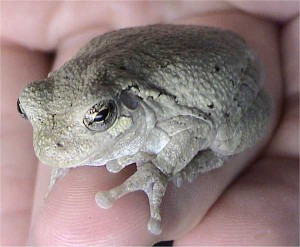
When I lived in Sioux City, IA, I had the opportunity of hanging out with a zoologist who studied the Plains Spadefoot Toad (Spea bombifrons). I would go out with her on nighttime listening surveys, and we would slowly drive the gravel farm roads in the middle of nowhere, weaving from one side to the other as we dodged hopping frogs and toads, and I would be amazed as the clamor of these calling anurans rattled my eardrums.
Just last week in Madison, as I took my lunchtime walk, I passed by a roadside wetland, and my ears filled with the calls of Chorus frogs, singing with all their one-inch might in hopes of attracting a mate. And, later that evening, as my daughter and I weeded our garden at home, I heard the crisp bell trill of two American toads carrying over the chorus frogs in the neighborhood.
Congresses of snoring Spadefoot Toads. In-your-face Copes Gray Tree Frogs. Peepers, Chorus Frogs and and Leopard Frogs. The evenings are noisy when the temperatures moderate and these frogs and toads come out to call. The din of the local roadside wetland begins to resemble the din of the local roadside bar, in more ways than one as it turns out.
In two recently published papers, Christina Richardson and colleagues investigate mate choice among female tree frogs (Hyla arborea) in southeast France. One paper investigates how female tree frogs discriminate male quality in this noisy environment of the frog “cocktail party”; and the second paper investigates whether these nocturnal tree frogs, thought primarily to select mates based on acoustic cues, might use some other criterion as well, in this case a visual cue like the color of the vocal sac.
In the first study, female European tree frogs were placed in an arena containing six speakers, each one broadcasting calls and background noise that varied in “attractiveness” based on three components: amplitude, frequency, and duration. Previously female tree frogs were shown to prefer calls with high amplitude, a low peak frequency, and short duration. In this study where female frogs were exposed to multiple calls of variable quality, they did not discriminate quality based on a single call component. However, when attractiveness was determined by all three components, call discrimination did improve a little. When the distances between the speakers doubled however, the discrimination became highly significant.
This study did not rule out that other cues may be in play as well. Hyla arborea females prefer males with a highly colorful vocal sac (in the absence of other cues). The coloration is carotenoid-based, and may be an indicator of immune condition, which could confer selective advantage. In their second study, Richardson and colleagues attempted to determine how female European tree frogs prioritize visual and acoustic cues. They presented females with a speaker broadcasting attractive or unattractive calls associated with a video of a male with attractive or unattractive vocal sac coloration. When audiovisual cues were both attractive, they were clearly preferred by the females over unattractive audiovisual cues. However, when attractive calls were combined with unattractive visual cues, only half of the females were interested, indicating that acoustic cues are not the only criteria for mate selection, at least in this species. It’s possible that these non-acoustic cues are particularly important when background noise and male density is high, such as frog “cocktail parties” when the entire community is turned out and chorusing.
So, perhaps the old adage, with some modification, is true: In order to find your handsome prince, you have to listen to a lot of toads and check out a few vocal sacs too, especially when you live in a noisy neighborhood.

Richardson, C., Gomez, D., Durieux, R., Thery, M., Joly, P., Lena, J., Plenet, S., & Lengagne, T. (2010). Hearing is not necessarily believing in nocturnal anurans Biology Letters DOI: 10.1098/rsbl.2010.0038
Richardson, C., & Lengagne, T. (2009). Multiple signals and male spacing affect female preference at cocktail parties in treefrogs Proceedings of the Royal Society B: Biological Sciences, 277 (1685), 1247-1252 DOI: 10.1098/rspb.2009.1836
Michele Arduengo
Latest posts by Michele Arduengo (see all)
- The Casual Catalyst: Science Conversations and Cafes - July 18, 2024
- Cancer Moonshot: Solving Tough Problems - May 28, 2024
- Automated Sampling and Detection of ToBRFV: An Emerging Tomato Virus - April 25, 2024
